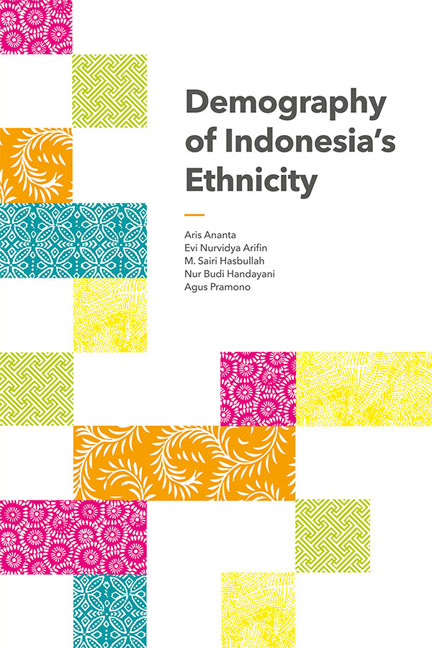Book contents
- Frontmatter
- Contents
- List of Tables
- List of Figures
- Foreword
- Acknowledgements
- 1 CHANGING INDONESIA: An Introduction
- 2 COMPLEXITY OF STATISTICS ON ETHNICITY: Concept, Data and Method of Analysis
- 3 THE NEW CLASSIFICATION: Uncovering Diversity
- 4 ETHNIC DIVERSITY: New Demographic Evidence
- 5 THE FIFTEEN LARGEST ETHNIC GROUPS: Age-Sex Structure and Geographical Distribution
- 6 CHANGE IN SIZE AND COMPOSITION OF ETHNIC GROUPS: Indonesia, 2000–2010
- 7 RELIGION AND LANGUAGE: Two Important Ethnic Markers
- References
- Appendix 1
- Appendix 2
- Index
- About the Authors
5 - THE FIFTEEN LARGEST ETHNIC GROUPS: Age-Sex Structure and Geographical Distribution
Published online by Cambridge University Press: 10 October 2017
- Frontmatter
- Contents
- List of Tables
- List of Figures
- Foreword
- Acknowledgements
- 1 CHANGING INDONESIA: An Introduction
- 2 COMPLEXITY OF STATISTICS ON ETHNICITY: Concept, Data and Method of Analysis
- 3 THE NEW CLASSIFICATION: Uncovering Diversity
- 4 ETHNIC DIVERSITY: New Demographic Evidence
- 5 THE FIFTEEN LARGEST ETHNIC GROUPS: Age-Sex Structure and Geographical Distribution
- 6 CHANGE IN SIZE AND COMPOSITION OF ETHNIC GROUPS: Indonesia, 2000–2010
- 7 RELIGION AND LANGUAGE: Two Important Ethnic Markers
- References
- Appendix 1
- Appendix 2
- Index
- About the Authors
Summary
This chapter elaborates on the various ethnic group populations, who can be seen as both consumers and producers of development. Specifically, the chapter examines the age-sex and geographical distribution of these ethnic groups. These data are especially useful for marketing and for both commercial and non-commercial purposes. In democratizing Indonesia, this knowledge is also very important for analysing electoral behaviour and understanding geopolitics.
In Chapter 4, we showed how we have classified 145 ethnic groups as belonging either to the ten largest, the fifteen largest or the twenty-five largest ethnic groups in the various provinces. However, it is beyond the scope of this chapter to discuss all of these groups in detail. Instead, we focus here on the age-sex structure (often called the population pyramid) and the geographical distribution of the fifteen largest ethnic groups in Indonesia in 2010.
LIFE-CYCLE APPROACH
Following a life-cycle approach, we disaggregate the population into different stages, each with a different impact on society and the economy. In this book, we classify a population into five age groups: infants and toddlers (0–4), children (5–14), youths (15–24), prime-working-age adults (25–59) and older persons (60 years and above).
Infants and toddlers (0–4) are highly physically and financially dependent and potential recipients of health services in their early years. They need caregivers to support them. Children (5–14) are also potential ‘customers’, as they are financially dependent on adults. At these ages, they cost their parents most in terms of their education. Altogether, the population aged 0–14 potentially burdens the economy with spending on health and education. At the same time, this expenditure can also be seen as investment in human capital for the nation.
Next to the dependent infants, toddlers and children are the youths (15–24). This group can be costly if the parents have higher aspirations to provide their children with tertiary education (until age 24). Therefore, youths may be added to the group of dependants (infants, toddlers and young children). In addition, youths are in transition to adulthood, ranging from entering the labour market, searching for a partner, starting a career and building a family. The youth bulge, often associated with negative things such as crime, is defined when the percentage of youths exceeds 20 per cent.
The top part of the population pyramid is the group of older persons, aged 60 years and above.
- Type
- Chapter
- Information
- Demography of Indonesia's Ethnicity , pp. 131 - 218Publisher: ISEAS–Yusof Ishak InstitutePrint publication year: 2014

